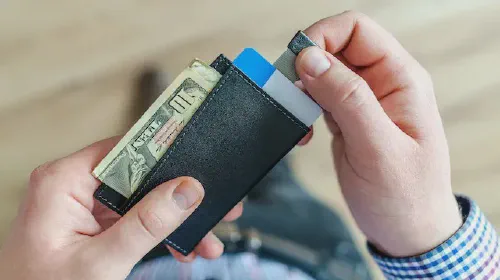Crypto Wallet Recovery Phrase: Definition, Importance, and Usage
Salomon Kisters
Feb 15, 2023This post may contain affiliate links. If you use these links to buy something we may earn a commission. Thanks!
A crypto wallet recovery phrase is a set of words that are used to recover or restore a cryptocurrency wallet. It is also known as a “seed phrase” or “mnemonic phrase.”
These phrases are generated when a wallet is first created and can be used to restore the wallet if the device it is stored on is lost or broken, or if the user forgets their password. The recovery phrase can be used to recreate the private keys for the wallet, giving the user access to their funds again.
The recovery phrase is usually a series of 12-24 words that are generated when the wallet is first created and should be written down and stored in a safe place, as it is the only way to access the funds in the wallet if the device is lost or the password is forgotten. It is important to keep the recovery phrase safe as anyone who has access to it can gain access to the funds in the wallet.
Additionally, most crypto wallets have a feature to validate the phrase. It’s a good idea to validate and make sure that the phrase is correctly entered, as a small typo can make it impossible to recover the wallet.
Now, let’s take a look at what private and public keys are, and how they are important in securing your actions on the blockchain. We’ll then look at the first crypto wallet, ways to store crypto wallet recovery phrases securely, what to do if you lose your recovery phrase, etc. to help you gain a better understanding of how these things work.
What are Private and Public Keys?
In the context of cryptocurrency, a private key is a secret code that is used to access and manage a user’s funds in a wallet. It is a unique code that is generated when the wallet is created and stored on the user’s device. The private key is used to sign transactions and must be kept secret at all times, as anyone who has access to it can access and spend the funds in the wallet.
A public key, on the other hand, is a code that is generated from a private key and is used to receive funds in the wallet. It is not a secret and can be freely shared with others. The public key is also known as the wallet address and is used to identify a specific wallet on the blockchain network.
Private keys and public keys are important in all forms of cryptographic communication. Other applications that are not blockchain-based (WhatsApp, for example), use private and public keys to ensure that no third party can gain access to private communication.
What Was The First Crypto Wallet?
The first crypto wallet is believed to be the Bitcoin-Qt wallet (now known as Bitcoin Core), which was created by Satoshi Nakamoto, the pseudonym used by the anonymous person or group who created Bitcoin. The wallet was first released in 2009 as part of the original Bitcoin software.
Bitcoin-Qt was a full-node desktop wallet that allowed users to download the entire Bitcoin blockchain and store it on their computers. It also allowed users to create new addresses, send and receive Bitcoin transactions, and manage their private keys. The wallet was considered to be the reference client for the Bitcoin network and was widely used by early adopters of the cryptocurrency.
It’s worth noting that Satoshi Nakamoto never claimed to have created the first crypto wallet, it was the first one that was widely used and it became the reference client, it was not the first attempt at creating a wallet.
Ways to Save Phrases Safely
There are several ways to store crypto wallet recovery phrases safely:
- Write down the recovery phrase on a piece of paper and store it in a safe or safety deposit box. This is a physical backup and can be useful in case of a lost or stolen device.
- Use a hardware wallet, such as a Trezor or Ledger, to store the recovery phrase offline. This is a secure option as it is not connected to the internet and therefore less susceptible to hacking.
- Use a software wallet that offers a password-protected recovery phrase option, such as MyEtherWallet or MetaMask. This method is less secure than a hardware wallet, but still provides an additional layer of protection.
- Use a cloud-based service, such as Google Drive or Dropbox, to store an encrypted version of your recovery phrase. This method is convenient, but it is important to ensure that the encryption is strong and that the service provider is reputable.
- Use a multi-sig wallet that requires multiple signatures for the transaction, It enables multiple parties to hold a copy of the recovery phrase. This provides an additional layer of security, as it means that the recovery phrase cannot be accessed or used by a single individual.
It’s important to note that no matter which method you choose, it is critical to keep your recovery phrase secret and to make multiple backups in case the original is lost or damaged.
What to do if you lose your Recovery Phrase
When you lose your recovery phrase, you lose access to your crypto wallet and any funds stored in it. This is because the recovery phrase is used to generate the private key, which is required to access the wallet and authorize transactions. The recovery phrase is a string of words that are generated when you create a new wallet. It is important to keep the recovery phrase safe and secure as it is the only way to access the wallet and the funds stored in it.
Without the recovery phrase, there is no way to recover the private key and therefore no way to access the funds stored in the wallet. The recovery phrase is the only way to regenerate the private key, and without it, the funds are lost forever. This is why it is extremely important to keep multiple copies of your recovery phrase in safe and secure places and to memorize it if possible.
It’s also important to note that there is no customer service or technical support team that can help you regain access to your funds if you lose your recovery phrase. It is the user’s responsibility to keep their recovery phrase safe and secure.
In summary, losing your recovery phrase means losing access to your crypto wallet and the funds stored in it, and it’s crucial to keep multiple copies of your recovery phrase in safe and secure places and to memorize it if possible.
Some Great Cryptocurrency Wallets
Some popular cryptocurrency wallets include:
- Ledger Nano S and Ledger Nano X: Hardware wallets that provide secure offline storage for a variety of cryptocurrencies.
- Trezor: Another popular hardware wallet that supports multiple cryptocurrencies.
- Exodus: A desktop wallet that supports multiple cryptocurrencies and has a built-in exchange feature.
- MyEtherWallet: A free, open-source, client-side interface for creating and managing Ethereum wallets.
- Electrum: A lightweight Bitcoin wallet that supports cold storage and multi-signature features.
- MetaMask: A browser extension that functions as an Ethereum wallet and allows users to interact with decentralized applications (dapps) on the Ethereum network.
While these wallets are generally considered to be reputable and secure, you should always conduct your own research and due diligence before using any wallet or storing any cryptocurrency.
Conclusion
Crypto Wallet Recovery Phrases are the key to the proverbial fortress. The most important possibility for human error and breach of security in the blockchain world resides in the recovery phrase domain since it requires users to store their keys; physically or digitally, in ways that the blockchain cannot protect.
In contrast, it is perhaps also important that there should be a safety net that allows one to recover resources that are based outside the confines of the blockchain, so in case of an attack on the blockchain, at least you have proof of ownership of your wallet and have the key to access it once things calm down agai
Stay informed with the latest insights in Crypto, Blockchain, and Cyber-Security! Subscribe to our newsletter now to receive exclusive updates, expert analyses, and current developments directly to your inbox. Don't miss the opportunity to expand your knowledge and stay up-to-date.
Love what you're reading? Subscribe for top stories in Crypto, Blockchain, and Cyber-Security. Stay informed with exclusive updates.
Please note that the Content may have been generated with the Help of AI. The editorial content of OriginStamp AG does not constitute a recommendation for investment or purchase advice. In principle, an investment can also lead to a total loss. Therefore, please seek advice before making an investment decision.

Pros and Cons of Cold Crypto Wallets
In this article, we will dive deep into the world of cold crypto wallets, explore their pros and cons, and help you make an informed decision about whether or not to use them for your own cryptocurrency storage needs.

Hardware Wallets: Secure and Convenient Cryptocurrency Storage
Hardware wallets are physical devices that offer a secure and convenient way to store and manage your private keys, providing added security and peace of mind for cryptocurrency holders.

Trust Wallet vs. Metamask: Trust Wallet Emerges as the Winner
Trust Wallet emerges as the winner over MetaMask due to its wider range of supported assets, multi-blockchain support, and user-friendly interface.
Protect your documents
Your gateway to unforgeable data. Imprint the authenticity of your information with our blockchain timestamp